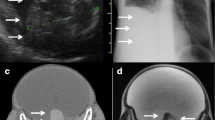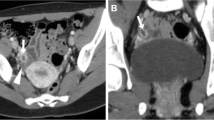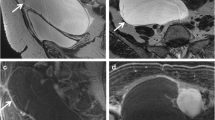Abstract
Objective
To analyze the imaging features of Struma ovarii (SO), and to correlate the imaging results with the pathological findings so as to enhance the knowledge of the imaging diagnostics of this disease.
Methods
The clinical records, CT and MRI features of twelve patients with pathologically proved SO were retrospectively analyzed. Imaging features were compared with pathological results.
Results
Most tumors (n = 11, 91.7%) were unilateral. In CT and MRI images, the lesions presented as defined irregularly shaped masses, showing mainly cystic (n = 6, 50%) or cystic (n = 6, 50%). The cystic portions presented as well defined, multiple, various size, and a whole cyst wall with smooth inner wall. Eight cases of tumors (66.7%) showed a high attenuation lesion in the cyst portion of the mass on CT precontrast scans, in which two cases showed high signal on T1WI and low signal on T2WI. The solid portions, which distributed in the cyst showed irregular tissue density. After contrast administration, the cystic portions showed no enhancement, the solid portions marked enhancement, and the cyst wall demonstrated no, moderate, or marked enhancement. Eight cases of tumors (66.7%) showed stippled calcification in the cyst wall. Four cases of tumors (33.3%) accompany a great of abdominal dropsy and pleural fluid.
Conclusions
In general, SO appeared as a smooth marginated multicystic mass with a high attenuation lesion on precontrast scans on CT scans, and signal intensities on T1-weighted images were partly intermediate to high, or high, and those on T2-weighted images were low. The CT and MRI characteristic findings of SO might be of great value for the diagnosis.




Similar content being viewed by others
References
Kempers RD, Dockerty MB, Hoffman DL, Bartholomew LG (1970) Struma ovarii—ascitic, hyperthyroid, and asymptomatic syndromes. Ann Intern Med 72:883–893
Roth LM, Talerman A (2007) The enigma of Struma ovarii. Pathology 39:139–146
Outwater EK, Siegelman ES, Hunt JL (2001) Ovarian teratomas: tumor types and imaging characteristics. Radiographics 21:475–490
Kim D, Cho HC, Park JW, et al. (2009) Struma ovarii and peritoneal strumosis with thyrotoxicosis. Thyroid 19:305–308
Loizzi V, Cormio G, Resta L, et al. (2005) Pseudo-Meigs syndrome and elevated CA125 associated with Struma ovarii. Gynecol Oncol 97:282–284
Teale E, Gouldesbrough DR, Peacey SR (2006) Graves’ disease and coexisting Struma ovarii: struma expression of thyrotropin receptors and the presence of thyrotropin receptor stimulating antibodies. Thyroid 16:791–793
Van de Mortele K, Vanbeckevoort D, Hendrickx S (2003) Struma ovarii: US and CT findings. JBR-BTR 86:209–210
Kim JC, Kim SS, Park JY (2000) MR findings of Struma ovarii. Clin Imaging 24:28–33
Dohke M, Watanabe Y, Takahashi A, et al. (1997) Struma ovarii: MR findings. J Comput Assist Tomogr 21:265–267
Matsumoto F, Yoshioka H, Hamada T, Ishida O, Noda K (1990) Struma ovarii: CT and MR findings. J Comput Assist Tomogr 14:310–312
Yamashita Y, Hatanaka Y, Takahashi M, Miyazaki K, Okamura H (1997) Struma ovarii: MR appearances. Abdom Imaging 22:100–102
Okada S, Ohaki Y, Kawamura T, Hayashi T, Kumazaki T (2000) Cystic Struma ovarii: imaging findings. J Comput Assist Tomogr 24:413–415
Joja I, Asakawa T, Mitsumori A, et al. (1998) Struma ovarii: appearance on MR images. Abdom Imaging 23:652–656
Jung SI, Kim YJ, Lee MW, et al. (2008) Struma ovarii: CT findings. Abdom Imaging 33:740–743
Imanishi Y, Ehara N, Shinagawa T, et al. (2000) Correlation of CT values, iodine concentration, and histological changes in the thyroid. J Comput Assist Tomogr 24:322–326
Acknowledgments
The study was funded by National Technology Research and Development (863) grant No.: 2006AA020904.
Author information
Authors and Affiliations
Corresponding authors
Rights and permissions
About this article
Cite this article
Shen, J., Xia, X., Lin, Y. et al. Diagnosis of Struma ovarii with medical imaging. Abdom Imaging 36, 627–631 (2011). https://doi.org/10.1007/s00261-010-9664-y
Published:
Issue Date:
DOI: https://doi.org/10.1007/s00261-010-9664-y




